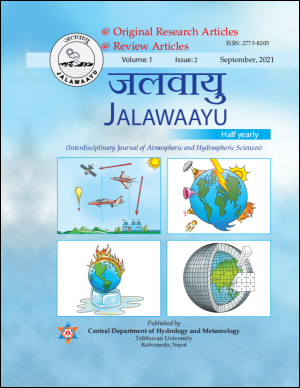Simulation of Rainfall over Bangladesh Using Regional Climate Model (RegCM4.7)
DOI:
https://doi.org/10.3126/jalawaayu.v1i2.41007Keywords:
RegCM4.7, Dynamic downscaling, Rainfall, Climate change, BangladeshAbstract
Regional climate model is a scientific tool to monitor present climate change and to provide reliable estimation of future climate projection. In this study, the Regional Climate Model version 4.7 (RegCM4.7) developed by International Centre for Theoretical Physics (ICTP) has been adopted to simulate rainfall scenario of Bangladesh. The study examines model performance of rainfall simulation through the period of 1991-2018 with ERA-Interim75 data of 75 km horizontal resolution as lateral boundaries, downscaled at 25km resolution using the mixed convective precipitation scheme; MIT-Emanuel scheme over land and Grell scheme with Fritsch-Chappell closure over ocean. The simulated rainfall has been compared both at spatial and temporal scales (monthly, seasonal and annual) with observed data collected from Bangladesh Meteorological Department (BMD) and Climate Research Unit (CRU). Simulated annual rainfall showed that the model overestimated in most of the years. Overestimation has been observed in the monsoon and underestimation in pre-monsoon and post-monsoon seasons. Spatial distribution of simulated rainfall depicts overestimation in the southeast coastal region and underestimation in the northwest and northeast border regions of Bangladesh. Better estimation of rainfall has been found in the central and eastern parts of the country. The simulated annual rainfall has been validated through the Linear Scaling bias correction method for the years of 2016, 2017, and 2018 considering the rainfall of 1991-2015 as reference. The bias correction with linear scaling method gives fairly satisfactory results and it can be considered in the future projection of rainfall over Bangladesh.
Downloads
Downloads
Published
How to Cite
Issue
Section
License

This work is licensed under a Creative Commons Attribution 4.0 International License.
Copyright © of the articles is held by the authors.

